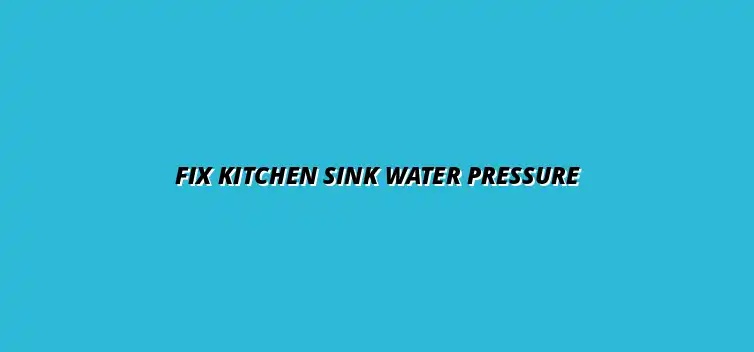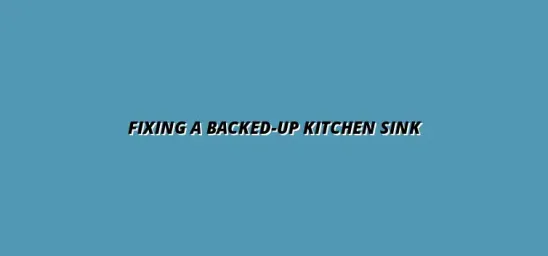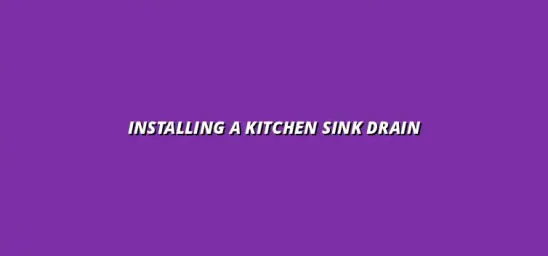
Fix Kitchen Sink Water Pressure
Understanding Water Pressure in Kitchen Sinks
Water pressure in kitchen sinks is a crucial aspect of any household. It affects everything from how well you can wash your dishes to the performance of appliances like dishwashers. When water pressure is optimal, tasks in the kitchen become quicker and easier, which is something we all want!
When the pressure is just right, you can enjoy a strong stream of water for rinsing fruits and vegetables or filling pots. This is why understanding water pressure is so important. It can make a notable difference in your daily kitchen experience.
The Importance of Optimal Water Pressure
Having the right water pressure is essential for a well-functioning kitchen. It ensures that you can use multiple faucets and appliances without experiencing a significant drop in performance. When water pressure is too low, it can lead to frustration and ultimately waste your time.
Optimal water pressure can also enhance the functionality of cleaning and cooking appliances. A steady flow helps to efficiently wash dishes, fill up pots for cooking, and even contributes to the performance of your dishwasher. In summary, it’s all about efficiency! For more tips on maintaining your kitchen plumbing, check out these essential kitchen plumbing maintenance tips.
Impacts on Everyday Kitchen Use
Low water pressure can turn simple tasks into chores. For example, washing dishes might take longer due to a weak water stream. Here are some common daily impacts of low water pressure:
- Longer time to fill pots and pans.
- Difficulty rinsing fruits and vegetables.
- Increased frustration during dishwashing.
When you notice these issues, it’s a sign that your kitchen sink's water pressure may need attention. Resolving these problems can save you time and make your kitchen experience much more enjoyable.
How Water Pressure Affects Appliance Efficiency
The efficiency of kitchen appliances is often directly linked to adequate water pressure. Appliances like dishwashers and refrigerators that include water dispensers depend on steady pressure for optimal performance. If the pressure is insufficient, these appliances may not function as intended. Learning how to unclog your sink with a plunger can also help maintain good water pressure.
Here are a few ways water pressure impacts your appliances:
- Dishwashers may not clean effectively.
- Ice makers can produce smaller or inconsistent ice cubes.
- Water filters may struggle to push water through efficiently.
In other words, maintaining the right water pressure is vital for ensuring your kitchen appliances work properly and last longer!
Common Causes of Water Pressure Issues in Kitchen Sinks
There are several reasons why you might experience low water pressure in your kitchen sink. Understanding these causes can help you troubleshoot and resolve the issues more effectively. Many times, the problems are simpler than you would expect!
From clogs in your plumbing to faulty fixtures, a variety of factors can contribute to decreased water pressure. Let’s explore some common culprits that could be lurking in your kitchen.
Clogs and Blockages in Plumbing
Clogs are one of the most common issues that can affect water pressure in kitchen sinks. Over time, food particles, grease, and debris can accumulate in the plumbing and block the flow of water. Recognizing these clogs early can save you from bigger plumbing headaches later! For information on preventing kitchen sink blockages, see this helpful guide on preventing kitchen sink blockages easily.
Several signs can indicate the presence of clogs in your kitchen sink:
- Water drains slowly when washing dishes.
- Unpleasant odors coming from the sink.
- Gurgling noises when the sink is in use.
If you observe any of these signs, it’s crucial to take action quickly. Ignoring the problem can lead to more severe plumbing issues in the future.
Identifying Signs of Clogs in Your Kitchen Sink
Identifying clogs early on is essential for maintaining good water pressure. In addition to the signs mentioned earlier, you might also notice that water levels rise in the sink instead of draining smoothly. This can be particularly frustrating when you’re in the middle of cleaning!
Furthermore, it’s a good practice to regularly check your sink and plumbing for any visible buildup or obstructions. Keeping an eye on your sink can help you catch potential problems before they become significant issues.
How Clogs Contribute to Low Water Pressure
When a clog forms, it restricts the flow of water, leading to low water pressure in your kitchen sink. This can affect both the hot and cold water lines, making it hard to get the water flow you need. As the blockage worsens, the pressure can drop even further, making tasks in the kitchen increasingly frustrating!
Ultimately, addressing clogs promptly is crucial for restoring optimal water pressure. Regular cleaning and maintenance can help prevent the buildup that leads to these frustrating clogs.
Faulty Faucets and Fixtures
Another common cause of low water pressure can be traced back to your kitchen faucet and fixtures. If your faucet isn't properly functioning, it can significantly impact your kitchen experience. Knowing the types of faucets you have can help in diagnosing these issues.
There are a few common types of faucets, each with its varying impact on water pressure:
- Compression faucets: These have a simple design but may wear out over time.
- Cartridge faucets: These are easier to repair but can also lead to pressure issues.
- Ball faucets: Common in kitchen sinks, they can suffer from mineral buildup.
Understanding these types can help you better assess your faucets when dealing with pressure issues.
Understanding Faucet Types and Their Impact on Pressure
The type of faucet you have can greatly influence water pressure. For example, older compression faucets often require more strength to turn and may be prone to leaks. In contrast, cartridge faucets are generally more efficient but can still become clogged over time.
Knowing your faucet type allows you to make informed decisions on repairs or replacements. Regular maintenance is key to preventing pressure issues from arising.
Maintenance Tips for Faucets to Avoid Pressure Issues
Maintaining your kitchen faucet is essential for keeping water pressure at optimal levels. Here are some effective maintenance tips:
- Regularly check for leaks and repair them promptly.
- Clean aerators to remove any mineral buildup.
- Inspect seals and washers for wear and replace them as needed.
By following these simple maintenance tips, you can prolong the life of your faucet and avoid low water pressure problems! For a comprehensive seasonal maintenance checklist, visit this seasonal plumbing maintenance checklist.
Pipe Problems and Plumbing Layouts
Pipes play a crucial role in determining your kitchen sink’s water pressure. Old, corroded, or improperly sized pipes can restrict water flow, leading to low pressure. It’s important to be aware of the condition of your plumbing system.
Additionally, the layout of your plumbing can contribute to pressure issues. A long distance between the water source and your faucet or multiple bends in the pipes can lead to pressure drops. Understanding your plumbing layout can help you identify potential trouble spots!
Assessing the Condition of Your Plumbing System
Regularly assessing your plumbing system is key to identifying potential issues. Look out for signs like rust, leaks, or strange noises that could indicate problems. Here are a few ways to assess your plumbing:
- Check for visible leaks around pipes.
- Listen for unusual sounds in the plumbing.
- Take note of any stains or discoloration on walls or ceilings.
If you notice any of these signs, it may be time to consult a plumber for a professional assessment. Taking action sooner rather than later can save you from larger issues down the road! For example, if you are in the Birmingham area, you might consider a plumber in Billesley, Birmingham for assistance.
How Pipe Size and Material Affect Water Flow
The size and material of your pipes can significantly impact water flow and pressure. Generally, larger diameter pipes allow for a greater flow of water, while smaller pipes can restrict flow. Additionally, materials like PVC, copper, or galvanized steel each have their unique properties.
Here are some key points to consider:
- PVC pipes are lightweight and resistant to corrosion.
- Copper pipes are durable but can be more expensive.
- Galvanized steel may corrode over time, affecting pressure.
Understanding these differences can help you make better decisions about your plumbing system and its maintenance!
Long-Term Solutions for Water Pressure Stability
To ensure that your kitchen sink maintains consistent water pressure, it's important to consider long-term solutions. These approaches not only enhance performance but can also save you money and hassle in the future. By upgrading your plumbing system and implementing smart devices, you can achieve a significant improvement in water flow. Learn how to prevent bathroom water pressure problems as well, for a more holistic approach to home plumbing.
Investing time and resources into these solutions will lead to a more efficient kitchen setup. Remember, maintaining ideal water pressure in your kitchen sink is about long-term care, so let’s explore some effective options!
Upgrading Your Plumbing System
One of the most effective ways to stabilize water pressure is by upgrading your plumbing system. This can involve replacing old pipes or fixtures that may be causing restrictions in water flow. Opting for high-quality materials can lead to better performance and durability.
When considering upgrades, look for materials such as copper, PEX, or PVC that can withstand pressure better than older materials. A well-maintained plumbing system can lead to fewer issues over time, ensuring your water pressure remains steady.
- Inspect and replace outdated pipes.
- Choose high-quality fixtures that complement your plumbing.
- Consider rerouting pipes for better flow.
Investing in High-Quality Pipes and Fixtures
Investing in high-quality pipes and fixtures pays off in the long run. These components often come with warranties and are designed to resist corrosion, which can lead to leaks and reduced water flow. Remember, the durability of your plumbing materials can significantly impact your kitchen's overall functionality.
Also, selecting fixtures that are designed for optimal water flow ensures that you won’t face sudden drops in pressure. This is especially important in busy households where multiple water sources are used simultaneously!
Benefits of Modern Plumbing Solutions
Modern plumbing solutions can bring a multitude of benefits, including improved water flow and energy efficiency. Utilizing technology in plumbing, such as smart valves and flow sensors, can help manage water pressure effectively. Additionally, these solutions can alert you to potential issues before they become serious problems. Addressing issues promptly can save you from larger problems, such as those related to your water heater.
Moreover, many modern fixtures are designed to be eco-friendly, helping reduce water waste while maintaining pressure. This means you not only save money on your water bill, but also contribute to environmental conservation!
Implementing Water Pressure Regulators
Water pressure regulators are essential devices that help maintain a consistent water flow throughout your home. By regulating the pressure entering your plumbing system, these devices can prevent fluctuations that lead to low pressure in your kitchen sink. Installing a pressure regulator can be a wise investment for long-term stability.
Additionally, they can protect your appliances by ensuring that they do not experience too much pressure, which can cause damage. A reliable water pressure regulator is key for anyone looking to maintain a steady flow!
How Water Pressure Regulators Work
Water pressure regulators function by reducing the incoming water pressure from the municipal supply to a safe and consistent level. They operate by using a spring-loaded diaphragm that adjusts based on the flow of water. As water flows through the regulator, it pushes against the diaphragm, which then opens or closes to maintain the set pressure.
This means that even if the municipal water supply experiences fluctuations, your home’s water pressure remains stable. This reliability can be especially beneficial during peak usage times when pressure drops are more likely to occur.
Choosing the Correct Regulator for Your Home
Selecting the right water pressure regulator for your home involves understanding your specific needs. Consider the following factors when making your choice:
- Measure the current water pressure in your home.
- Determine the flow rate required for your kitchen and appliances.
- Check compatibility with existing plumbing systems.
It’s vital to choose a regulator that can handle the demands of your household. Investing in the correct regulator will ensure your kitchen sink maintains optimal water pressure for years to come.
Final Thoughts on Maintaining Water Pressure in Your Kitchen Sink
Maintaining water pressure in your kitchen sink is crucial for both convenience and efficiency. By focusing on preventive techniques and long-term solutions, you can keep your plumbing system in top shape. Remember to regularly inspect your plumbing, choose quality fixtures, and consider installing a pressure regulator for added stability.
Staying proactive in water pressure management pays off! A little maintenance goes a long way in ensuring that your kitchen remains a functional and welcoming space where you can prepare meals without any interruptions.
Summary of Key Prevention Techniques
To recap, here are some key prevention techniques to maintain water pressure in your kitchen sink:
- Conduct regular plumbing inspections.
- Invest in high-quality pipes and fixtures.
- Install a water pressure regulator.
- Be proactive about addressing clogs and blockages.
These techniques will help you enjoy consistent water pressure and make your kitchen a more pleasant place to work!
Encouragement to Stay Proactive in Water Pressure Management
I encourage you to stay proactive when it comes to managing water pressure in your kitchen sink. Regular maintenance and timely upgrades can save you from bigger headaches down the road. Keep an eye on your plumbing system, and don't hesitate to reach out to professionals when needed. Your kitchen deserves the best!





Fixing a Backed-Up Kitchen Sink
Prepare Your Plumbing for Weather
Installing a Kitchen Sink Drain
When to Replace Plumbing Fixtures
Fixing a Jammed Garbage Disposal